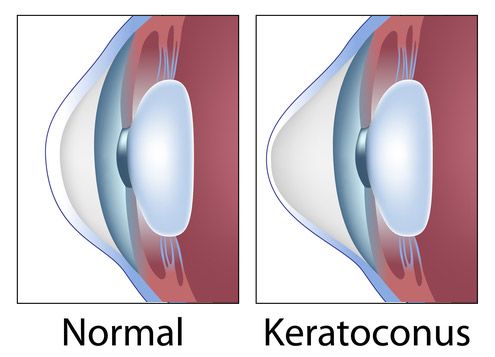
In addition to offers state-of-the-art laser vision correction surgery. Dr. Holzman and his team can also treat eye and cornea conditions such as keratoconus. Since many people are unfamiliar with keratoconus and what it involves, we’d like to go over the basics, including the symptoms to look for and your various treatment options.
About Keratoconus
Keratoconus is a condition in which the eye is irregularly shaped, resembling an oblong or a football-shape rather than a sphere. The condition is caused when the cornea (the transparent outer layer of the front of the eye) thins out. The thinning of the cornea results in the outward bulging of the eye and the change in overall eye shape.
Keratoconus typically occurs in both eyes and generally affects people between the ages of 10 and 25. It’s estimated that keratoconus affects around 1 in 500 people to 1 in 2,000 people.
How Keratoconus Affects Your Vision
When a person suffers from keratoconus, their overall vision quality tends to diminish. This includes issues with light sensitivity, glare, and clarity/crispness of vision. Ghost images, multiple images, and distortions of vision are also possible due to keratoconus.
Signs and Symptoms of Keratoconus
The most common signs and symptoms of keratoconus include the following:
- Distorted vision
- Blurry vision
- Issues with glare or halos
- Increased light sensitivity
- Clouding of vision
- Frequent changes in prescription
Be mindful of all of these potential symptoms and discuss them with your eye doctor or general practitioner so the condition can be diagnosed and addressed sooner rather than later.
Risk Factors for Keratoconus
The most common risk factor for keratoconus is a family history of the condition. If a relative experienced keratoconus, you are more likely to develop it.
Keratoconus is more likley in patients who suffer from certain genetic conditions as well, such as Down syndrome, Ehlers-Danlos syndrome, Leber’s congenital amaurosis, and osteogenesis imperfecta.
When You Should See a Doctor
It’s best to undergo medical treatment for keratoconus when you notice a steady or rapid decline in the overall quality of your vision. If you regularly undergo eye exams, this problem will likely be caught during your visit.
Treatments for Keratoconus
There are many different treatments available for keratoconus, and the ideal treatment option will depend on the severity of the condition.
For very mild forms of keratoconus, the use of prescription glasses and soft contacts is generally ideal. This will help address the vision problems caused by the irregular eye shape.
For more serious forms of keratoconus, various contact lenses are ideal. This includes the use of rigid gas permeable contact lenses, piggyback lenses (a hard contact lens over a soft contact lens), hybrid lenses (a rigid center with a soft outer rim), or scleral contact lenses (contact that rest on the white part of the eye without touching the cornea).
When non-surgical treatments prove ineffective or the keratoconus is severe, surgical treatments may be considered. This includes the use of corneal inserts to flatten out the conical bulging of the eye. If there is corneal scarring or major thinning of the corneas, a full corneal transplant (keratoplasty) may be recommended.
Schedule a Consultation with Dr. Andrew E. Holzman
To learn more about keratoconus and how it can be identified and properly treated, be sure to contact our advanced vision correction and eye care centers today. Dr. Andrew E. Holzman and his team will help you have great vision and healthy eyes.



